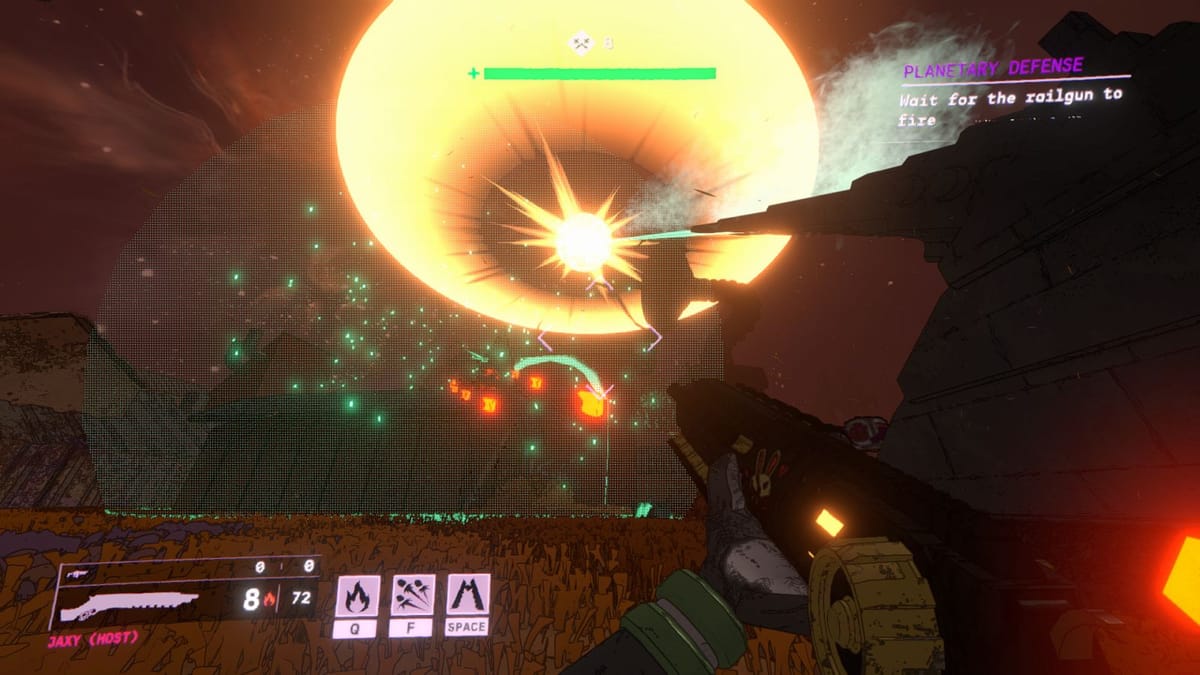
One of the first things I did while attending PAX East this year was hunt down the Devolver Digital booth. They have a tendency to back not only fun games, but stylish fun games, and this time around is no different. It seemed that everyone was lined up to play what the Pigeons at Play developers, clad in their cockroach costumes, were offering. I’m talking about Mycopunk, a co-op PvE FPS where you battle fungal life forms on behalf of a shady corporation.
Players start in a ship called The H.U.B. that’s orbiting a fungi-infested planet, before descending in a drop-pod-like ship to do the dirty, clean-up work. There are four characters for players to pick from: Wrangler, a cowbot with a lasso and dash; Bruiser, a support with a one way shield and ground pound attack; Scrapper, a short robot with a grapple pole and jetpack; and Glider, who wears a medic cross but has mostly offensive capabilities with a wingsuit and a rocket salvo ability that harms enemies and heals allies. There’s room for up to four players, so everyone can pick a different robot to add a broader range of abilities to the team, or players can pick the same bot to bet all of their power on one move set. You can play solo, invite friends, or hop into a publicly hosted game.
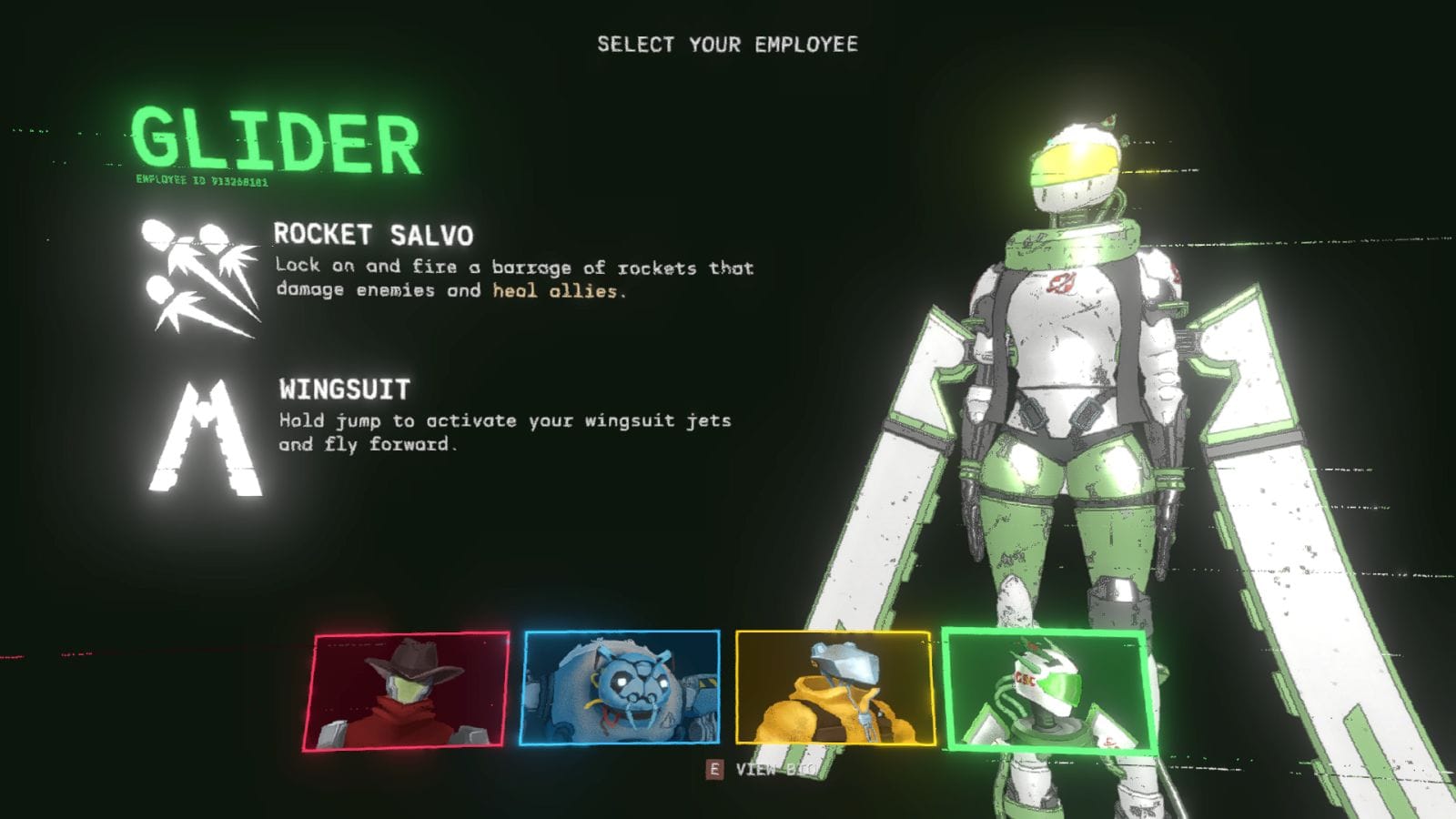
Currently, players have access to three game modes: Cleanup Detail, Planetary Defense, and Regulated Rampage. The first has you following a pipeline, shooting off the fungi that have attached to it. The second is a little more complex, with players needing to clear fungi off of power buildings, call down a rail gun, go through the steps to power it up, and then fire at an orbiting ship. Honestly, this mission blew me away with its scale. Once the railgun touches down on the planet, you have to shoot metal binders off the sides of the weapons platform to open it. This showcases both the size of the weapon and the utilitarianism of your sponsor company. Honestly, scale and interactivity can be hard to mesh, so big ups to Pigeons at Play for making it work. Finally, we have Regulated Rampage. There are fungi that need to be purged, so kill a lot of them and leave. That’s it, and that’s all it needs to be, as the combat in the game is strong enough for this mode to stand on its own. As you can tell, there’s a good range of complexity for the missions. There are also four other modes greyed out, so we can assume that they’ll be added in the future. Every mode has three levels of difficulty: safe, risky, and perilous. The harder the mission, the more XP you’ll get, and you could get rare materials for upgrading your weapons and gear, which we’ll get into later.
The enemies you fight while on a planet are, as mentioned, fungi. You might be thinking, “Kill some mushrooms? Easy!” Well, it would be, had these fungi not bonded with metal plating and learned to use high-tech upgrades they’ve scavenged. You see, every squishy core is protected by an armored ball, and that armored ball can be used to platform multiple upgrades like their standard scythe arms, shield bubble generators, lasers, and more! There’s also the tankier cube variety of enemy, which typically hosts larger, more complex modules. While a small enemy with a shield can only protect itself and maybe some nearby allies, the fungi in cubes can project a large bubble shield that protects an entire swarm. Players might also encounter fungi surrounded by large, diamond-shaped armor. I would say they’re about on par with the cubes’ power level. Then there are the elite boss enemies. When you see a big health bar pop up, you know you’re in for a challenge, as they have more health, stronger weapons, and more layers between your bullets and their vulnerable core. They even have some unique attacks, like firing rockets from their bodies. Pro tip: if you want to disable one of their weapons or shields, try aiming for weak spots such as their purple connecting arms and round joints.
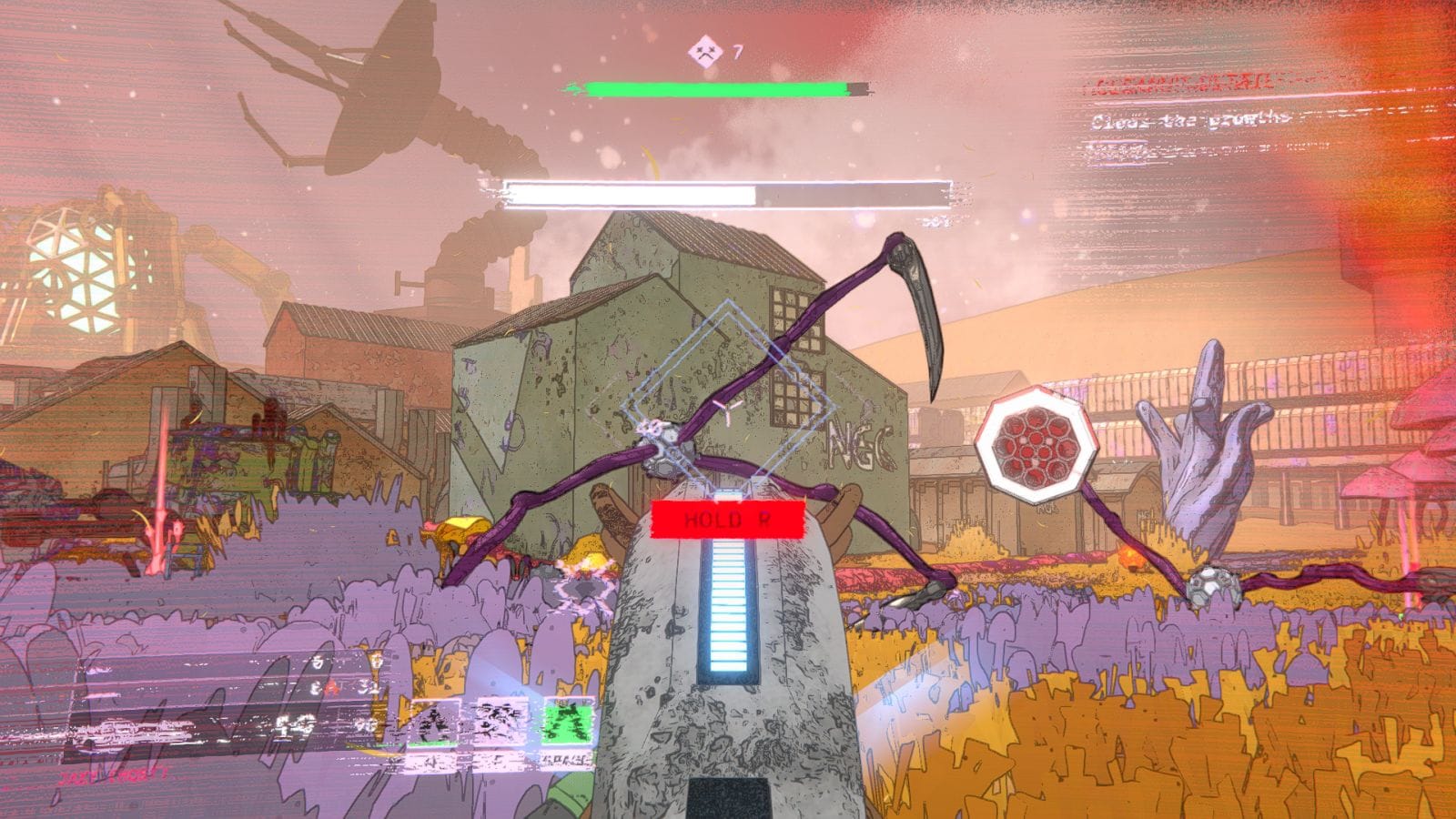
What really adds spice to the fights is when your adversaries scavenge their fallen comrades' parts to add to their own bodies. They can end up making some pretty powerful monstrosities this way, so make sure to destroy their weapons and utilities when they fall to the ground. While these combatants can be lethal, fungi aren’t the smartest, so occasionally they’ll pick up health packs for you to grab, or bombs that serve as weak points for you to detonate.
For the anti-fungal weapons themselves, there are currently five in the game, with one weapon option greyed out, presumably to be added in later. The weapons currently available include the Cycler, a standard SMG; the Jackrabbit, an incendiary lever-action shotgun with bullets that ricochet; the Swarm Launcher, which fires small pellets that track enemies; and the Gunship Cannon, which fires explosive shells. Saving the best for last, there’s the DMLR, a marksman rifle that fires powerful, accurate bolts which, when they hit a target, add fuel to the weapon’s secondary, highly destructive, laser mode. This bad boy is, in my opinion, the best gun in the game by far. Its fire rate allows it to crank out consistent, high-damage, long-range shots. Then you can swap to the laser and cut enemies down with ease. On top of weapons, there are currently three grenade types in the game: shock, incendiary, and acid. In the same vein as the Borderlands series, you get a satisfying burst of damage numbers when they hit an enemy. Last up is the old reliable melee attack, which is a punch that will one-shot weaker enemies. To be honest, the sheer cool factor of dashing around, precisely smacking enemy weak points to cripple them makes me wish for a few dedicated melee weapons. Swords or axes would certainly have amazing synergy with a lot of the movement kit in this game.
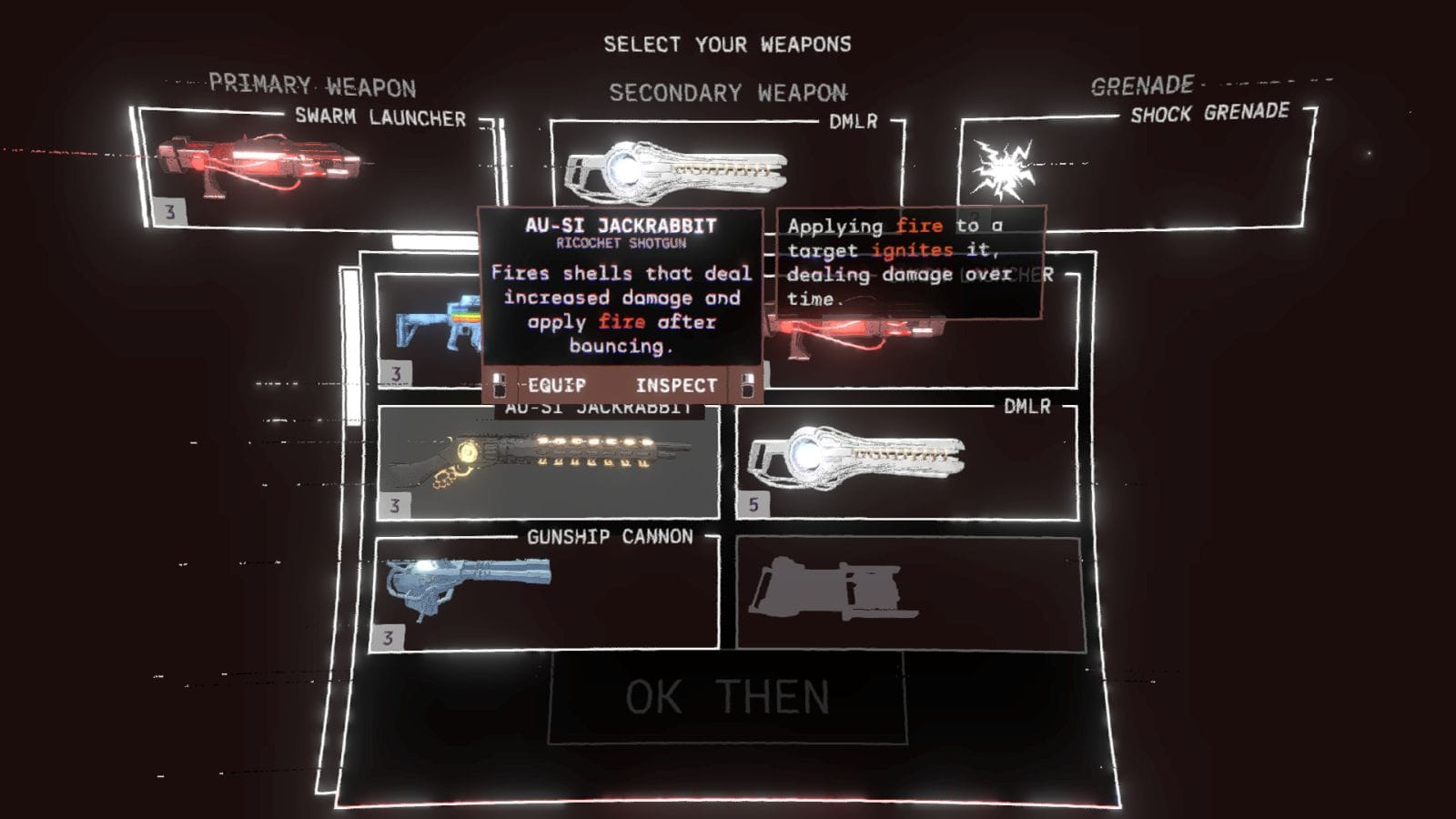
While five guns, three grenades, and a punch might not seem like a massive arsenal, the upgrade system allows you to tweak your guns and gear to your liking. Maybe you don't vibe with a gun at first, but you find upgrades that fundamentally change how you use it. For example, I wasn’t too fond of the Swarm Launcher when I first used it, as you have to hold to fire and release to unleash your swarm, and the damage didn’t feel consistent or powerful enough to justify the delay. Then, I found an upgrade that increases the magazine size for every unique upgrade I had, leading to a much stronger burst of damage. It went from a rainy drizzle to a lightning strike. After that, I discovered another upgrade that turned it fully automatic, which I really enjoyed. I went from being underwhelmed by a weapon to being torn between which playstyle I want to use for it. That’s quality progression right there.
Grenades benefit massively from upgrades. What starts out as generic elemental damage grenades gains a wide variety of effects that turn them into utility and support tools. Let's take a look at the acid grenade type. At first, it’s just a basic damage over time effect, but throw on the Deteriorate upgrade, and it makes enemies 35% more vulnerable to all damage for a whole minute. Maybe you added the Gas Valves upgrade to the mix, increasing your grenade recharge time while standing in the pool of acid it creates. This will urge players to get up close and personal, possibly changing their play style to take advantage of the effect. I found some other upgrades for the shock grenade, which boosted my team's movement speed or shot us into the air if we were in the area of effect, changing who I’m targeting with the grenades entirely.
The upgrade system could have just been a click-and-choose affair, but no, the system uses a grid, with each upgrade represented by a shape on that grid. I’m not usually the biggest fan of inventory management, but there’s something so invigorating about optimizing your patchwork of upgrades to fit in another buff. The developers thought it out well, as some upgrades benefit from how you organize. Remember that Swarm Launcher buff from earlier that increases the magazine size for each unique upgrade? Well, the thing is, the other upgrades have to be touching the magazine size upgrade for it to count, adding another layer to spatial management.
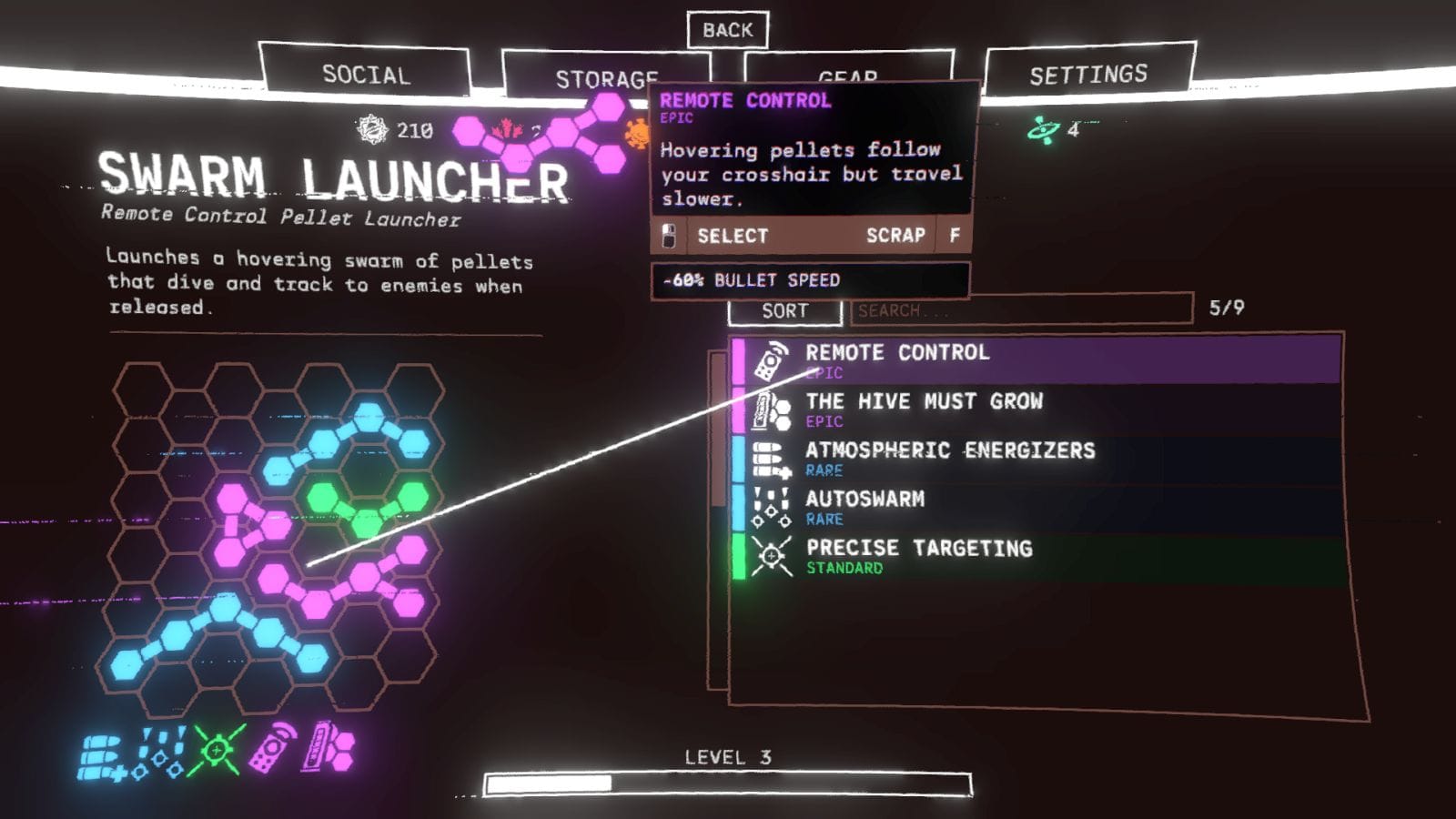
In order to actually unlock these upgrades, you’ll need to gather Gats, the standard galactic currency, and materials found on the planet's surface. Gats are simple, you get plenty just by completing missions. The various materials have different harvesting conditions, such as coating an enemy in a poisonous plant before killing them, or finding them in a container. Then there’s the highest level material, Saxonite, which can be earned by playing on higher difficulty levels.
Let’s move on to what happens after missions. Once you finish up your objective, you can call the ship back down by flipping a switch. Wait for it to arrive, get on, and don’t be late to take off or fall out while it’s ascending. Although death at this stage is largely just comedic, and you won’t lose anything if you do die. Next thing you know, you’re back to the mothership, your home-sweet-home. The overall look of the place is violently utilitarian, as if the ship has just enough to keep it held together. The home base’s design opens the door for all sorts of shenanigans with your friends. It’s surprisingly interactive, and it has little lore details everywhere. Race around with friends in little cars, heck, take ‘em down to the planet on your next mission and drive over enemies. Explore the ship, ride around on the rails, shoot some hoops, kill each other with those little scooters you used in gym class in 4th grade.
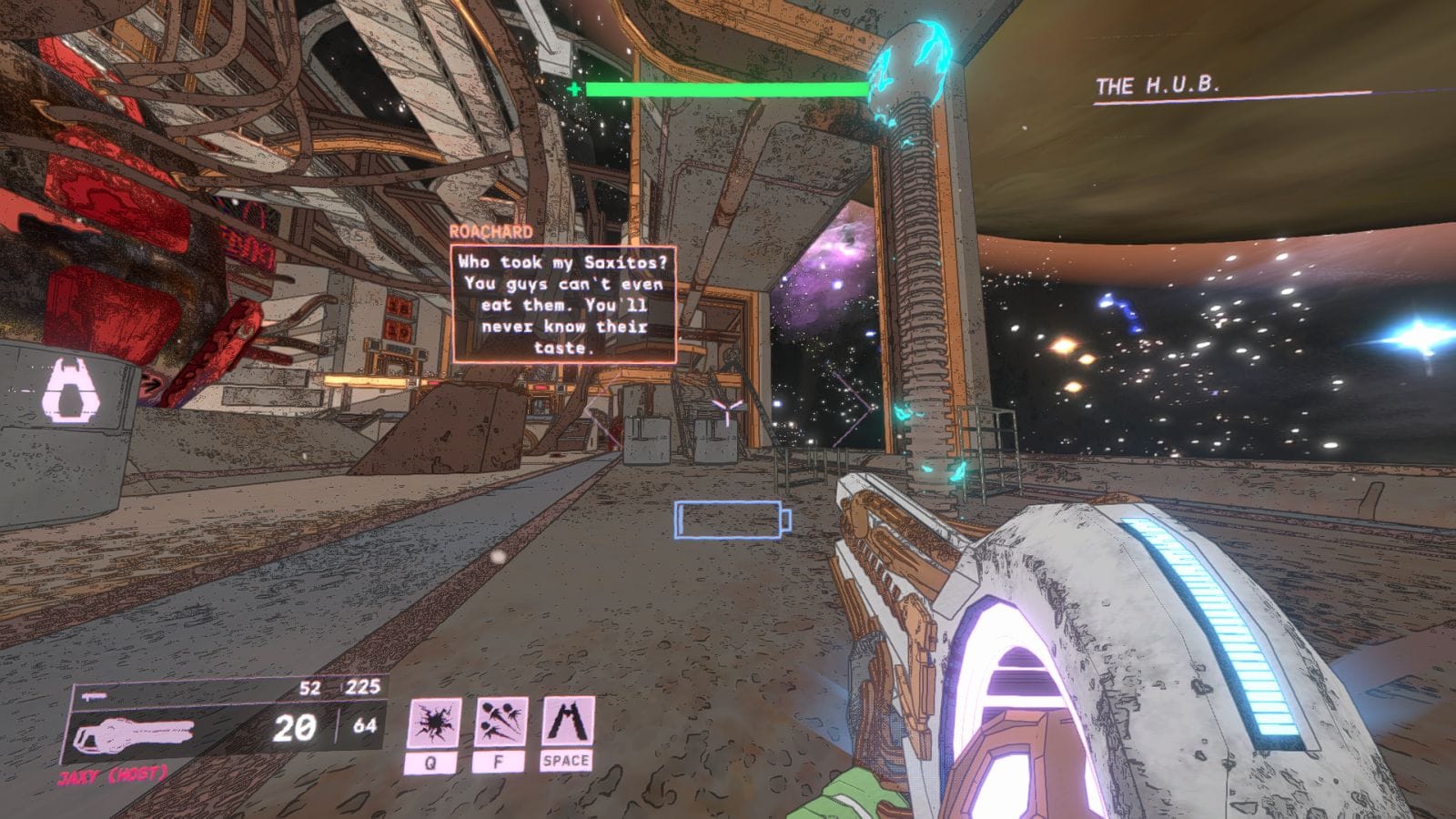
The chill background music is occasionally overpowered by the loud bang of meteorites hitting the side of the ship. Oh, and random comments from your guide, Roachard. He’s a talking cockroach with a southern accent and upbeat attitude. He’s also a fellow employee of Saxon Industries, the shady company commanding these operations. You can get a general feel for Saxon’s company culture by looking at the inspiring posters around the ship, one of which says, “Depression breeds inefficiency.” But don’t worry because another poster assures players that “Pleasure drugs are free* for full-time employees.” Maybe you noticed the asterisk in there, which elaborates, saying “Employee must cover additional fees, including but not limited to handling, shipping, processing, development, safe use education, and pleasure taxes.” But hey, those are just words; you really should let the variety of workplace hazards speak for themselves, like the broken pipe spraying what I hope is water all over the floor, or the random Tesla tower that zaps everything nearby if it’s disturbed, or even the unlabeled tube that spits out a live bomb if you activate it. It’s not all demotivational posters and OSHA violations, as you can find hidden messages and upgrades, too.
Honestly, I’m hyped for Mycopunk. It’s been a while since I’ve played a game that’s just pure, refined action. The weapons are unique, the upgrade system is engaging, and the scale is impressive. I hope the developers add more lore regarding Saxon Industries, and melee weapons would be an awesome plus, but for now, what I’m seeing is incredible. While there isn’t an exact release date yet, the Steam page lists 2025 as the general release window.
